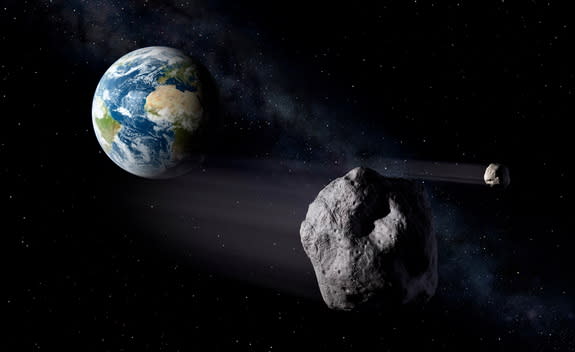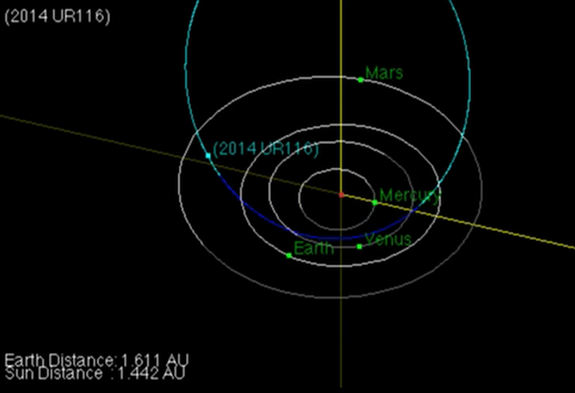Phew! Giant Asteroid Not a Threat to Earth, NASA Says
Claims that Russian scientists have discovered a huge asteroid that could threaten Earth in the near future are just not correct, according to NASA.
Recent news reports from Russia have stated that a researcher discovered a 1,312-foot (400 meters) space rock that could pose a danger to Earth. However, calculations from NASA and the Minor Planet Center in Cambridge, Massachusetts, show that the asteroid 2014 UR116 does not pose a danger to Earth for at least the next 150 years.
"Some recent press reports have suggested that an asteroid designated 2014 UR116, found on Oct. 27, 2014 at the MASTER-II observatory in Kislovodsk, Russia, represents an impact threat to the Earth," officials at NASA's Jet Propulsion Laboratory in California said in a statement Monday (Dec. 8). "While this approximately 400-meter sized asteroid has a three-year orbital period around the sun and returns to the Earth's neighborhood periodically, it does not represent a threat, because its orbital path does not pass sufficiently close to the Earth's orbit." [Potentially Dangerous Asteroids (Images)]
Asteroid UR116 was first seen about six years ago, according to the NASA statement. Officials have now re-computed the space rock's route around the sun and found that it poses no threat to Earth.
To track potentially dangerous cosmic objects (called near-Earth objects or NEOs) as they orbit the sun, NASA engages the help of amateur astronomers and professional space scientists around the world. After people discover and report a potentially dangerous NEO, officials map the comet or asteroid's path around the star to see if it intersects Earth's orbit in a potentially dangerous way.
Researchers are still discovering new NEOs all the time, but astronomers have already tracked many of these asteroids' orbits successfully. NASA officials estimate that they have found more than 90 percent of the NEOs in "Earth's neighborhood" that are 0.6 miles (1 kilometer) in diameter or larger. Scientists are now focusing on discovering 90 percent of NEOs 459 feet (140 m) in size or larger, according to NASA.
NASA is planning to launch a robotic mission to redirect an asteroid into orbit around the moon so that astronauts can explore the asteroid sometime in the 2020s. The asteroid redirect mission will also give NASA the opportunity to gather more data on how to change the orbit of a space rock if one should threaten Earth sometime in the future.
Asteroids are also important science targets for researchers interested in learning more about the beginnings of the solar system. Scientists think that asteroids, like comets, are leftovers from the dawn of the solar system, about 4.5 billion years ago, and learning more about their composition could help shed light on the history of Earth and other planets.
Follow Miriam Kramer @mirikramer. Follow us @Spacedotcom, Facebook and Google+. Original article on Space.com.
Copyright 2014 SPACE.com, a TechMediaNetwork company. All rights reserved. This material may not be published, broadcast, rewritten or redistributed.


